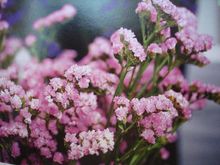Amaranth profile
Written by Maggie
Mar 18 2021

Amaranth is a flower of four seasons that never fades. Amaranth is an ambiguous term, referring to a flower native to the Mediterranean coast, because after a long bloom does not fade, colorful, similar to artificial flowers named; The other one is everlasting flowers, which are artificial flowers. It is a dried product of flowers made manually to keep the appearance and color unchanged.
Amaranth is a herbaceous plant, 50 ~ 79 cm tall, leaves are from the root, pinnately divided, growing in the stem base to the four directions. Flowers are at the end of spring, there are 3 ~ 5 long xun, triangular sections, calyx large, small and dense flowers, color has white, yellow, red, blue, purple and other colors.
Amaranth picture

Morphological characteristics of Amaranth
Amaranth is a herbaceous plant, 50 ~ 79 cm tall, leaves are from the root, pinnately divided, growing in the stem base to the four directions. Flowers are at the end of spring, there are 3 ~ 5 long xun, triangular sections, calyx large, small and dense flowers, color has white, yellow, red, blue, purple and other colors.
Amaranth flowers bloom after a long time, do not fade, colorful, similar to paper artificial flowers, are advanced cut flower materials.
Ecological habits of Amaranth
Amaranth prefers cold or warm environments.
Disease control of Amaranth
Amaranth's insect pests mainly include aphids, which can be controlled by spraying 40% dimethoate solution 1000 ~ 2000 times, 2.5% kung fu emulsion solution 4000 times, or death solution 6000 times, or 40% fenvalerate solution 6000 times.
Amaranth diseases are white rust and viral diseases.
White rust
More than 58% in the early onset of available ray mill a manganese zinc wettable powder 500 times liquid, 50% or a cream copper wettable powder 600 ~ 700 times liquid, 64% or antivirus alum wettable powder 500 times liquid, 60% or a cream aluminum-copper wettable powder 500 ~ 600 times liquid spray control, at the same time, spraying 30 ~ 50 ml per acre yield increasing fungus or plant treasure (6000 ~ 9000 times liquid, and used interchangeably, the effect is better.
Virus disease
It can be used anti-agent No. 1 300 ~ 400 times the liquid control, from the beginning of the seedling every 7 ~ 10 days to spray 1 times, continuous spray 3 ~ 4 times, or bacteria toxin Qing 200 ~ 500 times the liquid, every 7 days 1 time, continuous control 3 ~ 4 times.

The distribution of Amaranth
Amaranth originated from the Mediterranean coast and is now widely cultivated throughout the country.
Amaranth benefits
Nutrition
Amaranth boasts a magnificent nutrient resume, and like different pseudocereals, is a protein powerhouse. Amaranth is a whole protein, containing all nine vital amino acids, and at 14% protein, it carries shut to double the quantity located in rice and corn. In fact, researchers in Guatemala located it to be one of the most nutritious plant-based proteins. The benefits of amaranth’s protein do not now quit there – amaranth additionally incorporates lunasin, a peptide believed to have anti-inflammatory and cancer-preventive benefits. If you have celiac disease, be aware amaranth is one of many notable gluten free grain options!
Each entire grain offers a different combine of nutrients. Whole grain amaranth gives a top supply (greater than or equal to 10% of the advocated each day value) of protein, fiber, iron, selenium and the B vitamin, pyridoxine (B6). Amaranth is additionally an remarkable supply (greater than or equal to 20% of the endorsed each day value) of magnesium and phosphorus, and carries at least 1/2 of the endorsed every day fee of manganese, which helps metabolize protein and different macronutrients.
Edible value
Amaranth in its intact shape can be saved in the pantry for four months and in the freezer for eight Whole amaranth flours can be saved in the pantry for two months and in the freezer for up to four months.
To prepare dinner amaranth, mix one cup of dried grain with two cups of liquid. Bring to a boil then simmer for 15 to 20 minutes yielding 2.5 cups of cooked grain.
Latest Updated
- Benefits of Bugleweed - 7 Science-backed Health Benefits
- Bugleweed Dangers & Side Effects - Is It Poisonous?
- How to Plant Evergreen Trees - What You Should Know
- When to Plant Evergreens - Grow Guide for Evergreen Trees
- 12 Wonderful Evergreen Shrubs for Your Garden
- 12 Popular Evergreen Plants with Pictures for Beginners
- When And How To Prune A Lilac Bush Like a Pro
- How to Grow & Care for Lilac Vine (Hardenbergia Violacea)
- Japanese Lilac Tree (Syringa Reticulata) Care & Propagation Guide
- Shumard Oak Pros and Cons - What to Know
Popular Articles
- Winter maintenance of Antirrhinum Majus
- How to Grow Terminalia Mantaly Tree
- How to Grow and Care for Crossostephium Chinense
- How to grow Antirrhinum Majus in spring
- Peristeria Elata (Dove Orchid) Profile: Info & Care Guide
- Underwatered Snake Plant (Sansevieria Trifasciata) - Signs And How To Fix
- How to Care for Brazilian Jasmine Plant (Mandevilla Sanderi)
- How to Grow & Care for Graptopetalum Purple Delight in Summer
- Rosa Chinensis (China Rose): Plant Growing & Care Tips
- How to Care for Baby Sun Rose (Aptenia Cordifolia)